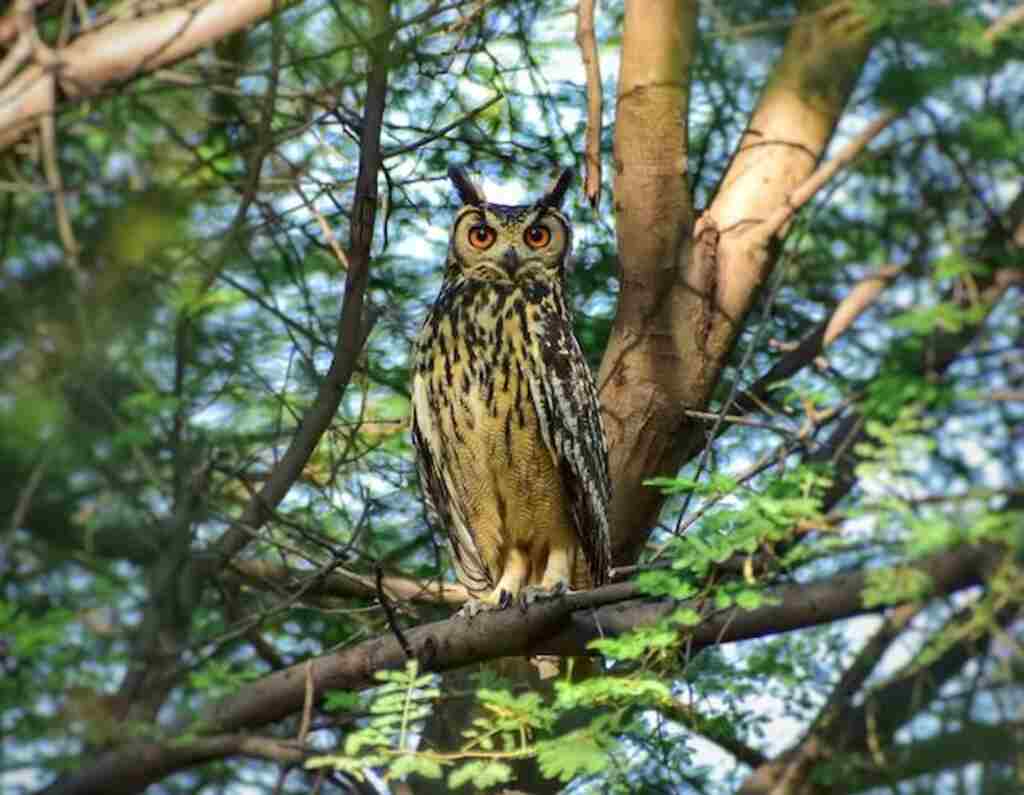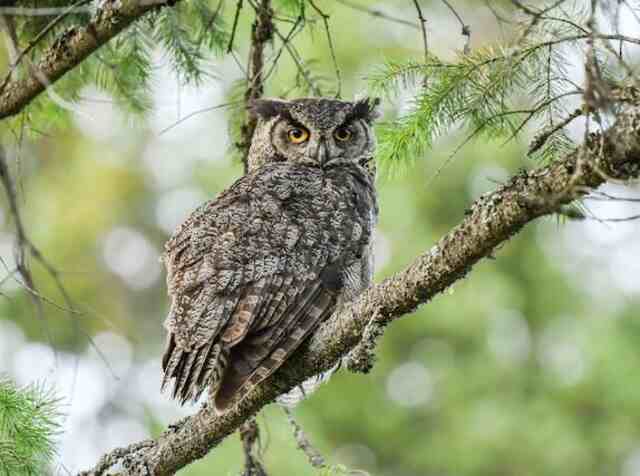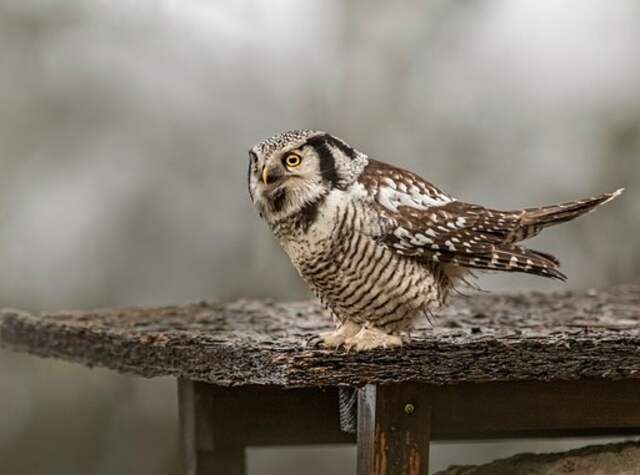Do owls eat fruit? Short answer: Yes! But why would a bird of prey opt for berries over mice? Join us on a fruity journey through the world of owls as we explore their unexpected eating habits.
From sweet treats to sour snacks, we’ll delve into the reasons why these nocturnal creatures sometimes choose to go vegetarian. Get ready to discover a whole new side to these feathered friends!
Table of Contents
- 1 The Predatory Nature of Owls
- 2 A Look at Common Prey Items for Owls
- 3 Do Owls Eat Fruit?
- 4 Reasons Why Owls Eat Fruit
- 5 The Bottom Line
- 6 Owls’ Diet Introduction:
- 7 Fruit in an Owl’s Diet
- 8 Why Owls Eat Fruit
- 9 Conclusion
- 10 FAQs: Do Owls Eat Fruit?
- 10.1 Can Owls Digest Fruits?
- 10.2 Why Would Owls Eat Fruit?
- 10.3 Which Types of Fruits Do Owls Eat?
- 10.4 Do Owls Get Nutrients From Fruits?
- 10.5 Is Eating Fruit Harmful to Owls?
- 10.6 Do Owls Eat Fruit in Captivity?
- 10.7 How Do Owls Digest Fruits?
- 10.8 Do All Owl Species Eat Fruit?
- 10.9 Can Fruit-Eating Owls Survive Without Prey?
- 10.10 Are Owls the Only Birds that Eat Fruits?
- 11 Author
The Predatory Nature of Owls
Owls are one of the most fascinating and majestic bird species in the world. They are known for their silent flight, large eyes, and sharp talons which make them top predators in their environment.
Owls have evolved to be excellent hunters, with incredible adaptations that allow them to capture prey with impressive accuracy.
While owls are famous for their predatory nature, many people may not know the extent of their diet or wonder if they eat fruit.
A Look at Common Prey Items for Owls
Owls tend to hunt small mammals such as mice, rats, voles and shrews. Depending on the owl species’s size and location, they might also catch birds such as quails or doves.
Snakes and frogs can also be on an owl’s menu, depending on habitat types. These prey items have adapted over time because of owls’ presence in their habitats; they developed features like camouflage or burrowing habits to better evade detection from predators like owls.
Owls have a unique digestive system that enables them to digest entire prey items, such as bones and fur.
After swallowing a whole mouse or a bird headfirst- its most common method- an owl will store it briefly in its crop before moving it down its esophagus into the stomach where acidic digestion begins.
Do Owls Eat Fruit?
Many people believe that all predatory birds have no interest in fruit due to their carnivorous nature but this is not entirely true.
Various birds’ species supplement their diets with fruits when available; examples include toucans who feed heavily on fruits like figs and parrots who consume various berries
But what about owls? Some research shows that owls may consume fruits if it’s available and when prey items are scarce.
There are anecdotal sightings of barn owls eating figs, for instance, in Israel. Researchers also observed that screech owls could feed on various berries such as wild grape and elderberries.
Reasons Why Owls Eat Fruit
While it may seem surprising that owls would eat fruit, there are actually good reasons why they might do so. First, fruits contain valuable nutrients such as vitamins and minerals necessary for birds’ survival.
Second, the high water content in fruits helps with hydration, which is an essential aspect of their daily metabolic processes. The fiber present in fruits aids digestion, since owl diets can be heavy on protein but low in fiber.
Additionally, changes to an owl’s environment like habitat loss or natural disasters could lead to a decrease in prey availability.
Supplementing their diet with fruit could serve as a great adaptation strategy to cope up with the scarcity of prey items temporarily.
The Bottom Line
While owls primarily rely on small mammals and birds for their diet-they have been seen consuming fruit occasionally under certain circumstances like prey shortages or nutritional benefits supplementation.
Therefore, we cannot disregard any opportunity for additional knowledge about these fascinating birds’ complex dietary requirements and the factors that influence them over time.
Owls’ Diet Introduction:
Owls have a reputation for being skilled hunters and predators, and for good reason. These birds of prey have sharp talons, powerful beaks, and impressive night vision that make them efficient hunters.
They are known to hunt a variety of prey items depending on the species, including rodents, insects, fish, and small mammals. Understanding the diet of an owl is key to understanding its behavior and ecology.
Explanation of Typical Owl Diet
In general, owls are carnivorous birds that eat a variety of small prey items. The most common prey items for owls are rodents such as mice and voles.
However, some larger owl species like the great horned owl can even take down rabbits or other small mammals such as skunks or possums.
Other than rodents and small mammals, owls also feed on insects like grasshoppers or crickets. Some owls specialize in hunting fish near water sources, while others may eat reptiles like lizards or snakes.
The specific diet of an owl will depend on its geographic location, habitat type, and individual preferences within their species.
For example, barn owls tend to prefer hunting near fields while snowy owls may specialize in hunting along coastlines, where their white feathers provide camouflage against the snow.
Discussion of How Owl’s Digestive System Works
Owls have a unique digestive system that allows them to efficiently break down their food into usable nutrients while expelling waste materials quickly. When an owl captures its prey with its talons or beak, it swallows it whole without chewing it first.
The food travels down the esophagus into the proventriculus which is essentially a stomach that secretes digestive juices containing enzymes like pepsin that break down proteins into smaller peptides.
From there, the food moves into the ventriculus or gizzard, which acts as a mechanical processor. The gizzard contains small stones and other debris that can help break down the food further.
After processing in the ventriculus, the food moves into the intestines, where nutrients are absorbed while waste materials are expelled.
What’s interesting about an owl’s digestive system is that it produces pellets of undigested material, which are then regurgitated by the owl.
These pellets contain bones, fur, and other materials that couldn’t be broken down in their digestive tract. Conclusion:
Owls have a varied carnivorous diet consisting of rodents, small mammals, insects and even fish or reptiles depending on species and habitat.
Their unique digestive system allows them to efficiently extract nutrients from their prey while expelling waste materials quickly in pellets.
Understanding an owl’s diet is key to understanding its behavior and ecology, as well as its role in the ecosystem it inhabits.
Fruit in an Owl’s Diet
Examples of fruit-eating birds (parrots, toucans)
While it may seem unusual for owls to eat fruit, there are many bird species that incorporate fruit into their diets. Some well-known examples include parrots and toucans.
These birds can consume large quantities of fruit each day, which makes up a significant portion of their diet.
However, it is important to note that not all birds can digest fruit equally well. Some species have specialized digestive systems that allow them to break down tough seeds and fibrous plant material.
Research on owls and fruit consumption
Despite the fact that owls are primarily known as predators of small mammals and insects, there have been several studies conducted on the role of fruit in an owl’s diet. One such study examined the diet preferences of screech owls in North America.
The researchers found that these owls showed a preference for berries during certain times of the year when other prey items were scarce. Another study documented observations of barn owls eating figs.
The researchers were surprised to see these predatory birds consuming such a high quantity of fruit, but noted that they appeared to be doing so opportunistically – likely due to a lack of alternative food sources.
In addition to scientific studies, there are also many anecdotal reports from bird watchers who have observed owls consuming various types of fruits.
While these observations alone cannot provide definitive evidence for the role of fruit in an owl’s diet, they do suggest that this behavior is more common than previously thought.
Studies on screech owls and their preference for berries
In one study conducted by researchers from Florida Atlantic University and Eastern Kentucky University, the diets of Eastern Screech-Owls were analyzed using fecal samples collected over a period spanning multiple seasons.
The researchers found that during the winter months, when prey items were scarce, screech owls showed a marked preference for berries.
The berries most commonly consumed by these birds were those of the American beautyberry (Callicarpa americana) and the southern wax myrtle (Myrica cerifera).
Interestingly, these fruits contain high levels of antioxidants and other nutrients that can be beneficial to birds in times of stress or illness.
Observations of barn owls eating figs
In another study conducted by researchers from Spain and Israel, barn owls were observed feeding on figs in an orchard setting.
The researchers placed GPS trackers on several owls to monitor their movements and found that they visited the orchard frequently during the fruiting season.
The owls were observed consuming both ripe and unripe figs, with some individuals consuming as many as 10-15 figs in a single night.
While it is unclear why these birds are consuming so much fruit, it is possible that they are doing so opportunistically due to a lack of alternative prey.
Anecdotal evidence from bird watchers
While scientific studies provide valuable insights into an owl’s diet, there is also a wealth of anecdotal evidence from bird watchers who have observed these birds eating fruits like grapes, cherries, and even watermelon.
One particularly interesting observation involved a great horned owl consuming blackberries directly from the plant – something not commonly seen in predatory birds.
While anecdotal observations are not as rigorous as scientific studies, they do suggest that fruit consumption may be more common among predatory birds than previously thought.
It is possible that these birds are turning to fruit as a source of nutrition during times when prey items are scarce or difficult to find.
Alternatively, they may simply be opportunistic feeders taking advantage of whatever food sources are available to them at any given time.
Why Owls Eat Fruit
Owls are known for their carnivorous diet, with rodents, insects and small mammals being their typical prey. However, there has been increasing evidence of owls consuming fruits as well.
So why would a predator like an owl eat fruit? One reason is the nutritional benefits that fruits provide to birds.
Nutritional Benefits of Fruit for Birds
Fruits are rich in vitamins and minerals that are essential for bird health. For example, apples contain vitamin C which helps boost the immune system and aids in collagen production for healthy skin and feathers.
Bananas contain potassium, which helps with muscle function and can prevent cramping. In addition to vitamins and minerals, fruits also contain antioxidants that help reduce inflammation and protect cells from damage caused by free radicals.
Vitamins and Minerals Found in Fruit
Owls can benefit from the variety of vitamins and minerals found in different types of fruit. For example, blueberries are high in vitamin C, vitamin K, fiber, manganese, copper, iron; all of which aid digestion while helping maintain good bone health.
Pears on the other hand provide potassium, which helps with muscle contraction regulation while promoting healthy brain function.
Incorporating fruit into an owl’s diet gives it a more balanced nutrient intake – not only protein but also carbohydrates (from sugars), fiber as well as these essential vitamins and minerals.
High Water Content Helps with Hydration
Fruit contains high water content, making it an excellent source of hydration, especially during dry weather conditions where access to clean water may be limited or scarce for owls hunting in the wild.
Furthermore, introducing hydration-rich fruit provides owls with better digestion relief from dry mouth or throat issues while enabling them to save energy for hunting prey, thus avoiding dehydration-related illnesses such as heat stroke or kidney disease.
Fiber Aids Digestion
Fruit is also a good source of dietary fiber that aids digestion by promoting healthy bowel movement and preventing constipation.
This is particularly important for birds like owls, whose digestive systems are relatively slow compared to other species. Including fruit in their diet can help keep their digestive system running smoothly.
Adaptation to Changing Environments Where Prey May Be Scarce
Incorporating fruit into an owl’s diet may be a sign of adaptation to changing environments, where prey may be scarce due to factors such as climate change or over-hunting.
In these situations, adding more variety to their diet may help sustain them until more prey becomes available.While owls are primarily carnivorous, they have been observed consuming fruits as well.
The nutritional benefits of fruits including vitamins, minerals, antioxidants and hydration make it an excellent addition to their diets especially in times of scarcity when traditional prey sources might be limited.
Conclusion
After examining various studies and observations, it is clear that owls do, in fact, consume fruit as part of their diet. While fruit may not make up a significant portion of their diet, it can still provide nutritional benefits for these birds of prey.
Owls are known to adapt to changing environments where prey may be scarce, and adding fruit to their diet is one way they can survive in such situations.
It is important to understand the complexities of animal diets and the adaptations they make in order to thrive in different environments.
As humans encroach further into natural habitats, it is essential that we learn as much as we can about the animals that inhabit those spaces. This includes understanding what they eat and how they obtain necessary nutrients.
While some people may view owls consuming fruit as unusual or even unexpected behavior, it serves as a reminder that animals are capable of adapting in unique ways to ensure their survival.
It also highlights the importance of research and observation when studying animal behavior.
While the question “Do owls eat fruit?” may seem straightforward, the answer showcases the complexity of animal diets and serves as a reminder of how much we still have to learn about our feathered friends.
FAQs: Do Owls Eat Fruit?
Can Owls Digest Fruits?
Yes, Owls can digest fruits, but it’s not a typical part of their diet. While Owls are primarily carnivorous, they occasionally eat fruits, berries, and seeds, especially when prey is scarce.
Why Would Owls Eat Fruit?
Owls may eat fruit for several reasons, such as supplementing their diet when prey is scarce, fulfilling their need for water, or as a result of accidental ingestion while hunting for prey.
Which Types of Fruits Do Owls Eat?
Owls have been observed eating various types of fruits, including berries, grapes, apples, pears, and figs. However, the frequency and quantity of fruit in their diet depend on their species, location, and the availability of prey.
Do Owls Get Nutrients From Fruits?
Yes, Owls can obtain nutrients from fruits, such as vitamins, minerals, and antioxidants. However, these nutrients may not be sufficient for their energy needs, as Owls require a high-protein diet to sustain their metabolism and hunting abilities.
Is Eating Fruit Harmful to Owls?
Eating fruit is generally not harmful to Owls, as long as it’s not their primary source of food. However, some fruits, such as avocado and persimmon, contain toxic substances that can be harmful to Owls and other animals.
Do Owls Eat Fruit in Captivity?
Yes, Owls in captivity may be offered fruits as part of their diet, along with other food items such as mice, rats, and insects. However, their dietary requirements may vary based on their species, age, and health condition.
How Do Owls Digest Fruits?
Owls digest fruits similarly to how they digest other food items, such as prey and insects. The fruits pass through their digestive system and are broken down by enzymes and stomach acids, with the nutrients absorbed into their bloodstream.
Do All Owl Species Eat Fruit?
No, not all Owl species eat fruit, and the frequency of fruit in their diet varies widely. Some species, such as the Northern Saw-whet Owl, rarely eat fruit, while others, such as the Eastern Screech-Owl, may consume fruits more frequently.
Can Fruit-Eating Owls Survive Without Prey?
While Owls can survive for a short period without prey, relying solely on fruits may not provide sufficient energy and nutrients for their long-term survival. Owls are adapted to hunting and require a high-protein diet to maintain their physical and cognitive abilities.
Are Owls the Only Birds that Eat Fruits?
No, Owls are not the only birds that eat fruits. Many bird species consume fruits, berries, and seeds as part of their diet, especially during the non-breeding season when insects and prey are scarce. Some examples of fruit-eating birds include thrushes, waxwings, and finches.







